《DSP using MATLAB》Problem 7.30

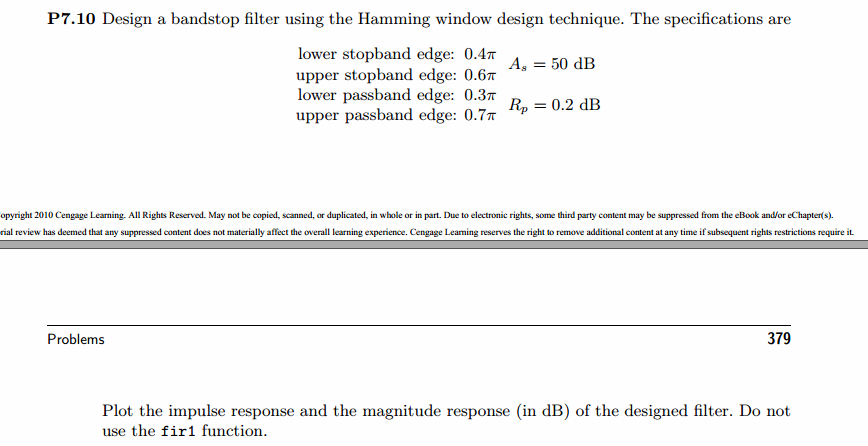
代码:
%% ++++++++++++++++++++++++++++++++++++++++++++++++++++++++++++++++++++++++++++++++
%% Output Info about this m-file
fprintf('\n***********************************************************\n');
fprintf(' <DSP using MATLAB> Problem 7.30 \n\n'); banner();
%% ++++++++++++++++++++++++++++++++++++++++++++++++++++++++++++++++++++++++++++++++ % bandstop, Length MUST be odd number.
wp1 = 0.3*pi; ws1 = 0.4*pi; ws2 = 0.6*pi; wp2 = 0.7*pi;
As = 50; Rp = 0.2; [delta1, delta2] = db2delta(Rp, As);
deltaH = max(delta1,delta2); deltaL = min(delta1,delta2); f = [wp1, ws1, ws2, wp2]/pi; m = [1, 0, 1]; delta = [delta1, delta2, delta1]; [N, f, m, weights] = firpmord(f, m, delta);
N h = firpm(N, f, m, weights);
[db, mag, pha, grd, w] = freqz_m(h, [1]);
delta_w = 2*pi/1000;
wp1i = floor(wp1/delta_w)+1; ws1i = floor(ws1/delta_w)+1;
ws2i = floor(ws2/delta_w)+1; wp2i = floor(wp2/delta_w)+1; Asd = -max(db(ws1i : 1 : ws2i)) M = N + 1
l = 0:M-1;
%% --------------------------------------------------
%% Type-1 BPF
%% --------------------------------------------------
[Hr, ww, a, L] = Hr_Type1(h); Rp = -(min(db(1:1: wp1i))); % Actual Passband Ripple
fprintf('\nActual Passband Ripple is %.4f dB.\n', Rp); As = -round(max(db(ws1i : 1 : ws2i))); % Min Stopband attenuation
fprintf('\nMin Stopband attenuation is %.4f dB.\n', As); [delta1_db, delta2_db] = db2delta(Rp, As) % Plot
figure('NumberTitle', 'off', 'Name', 'Problem 7.30 h(n), Parks-McClellan Method')
set(gcf,'Color','white');
subplot(2,2,1); stem([0:M-1], h); axis([0 M-1 -0.3 0.7]); grid on;
xlabel('n'); ylabel('h(n)'); title('Actual Impulse Response, M=47'); subplot(2,2,2); plot(w/pi, db); axis([0 1 -90 10]); grid on;
set(gca,'YTickMode','manual','YTick',[-51,-9,0])
set(gca,'YTickLabelMode','manual','YTickLabel',['51';' 9';' 0']);
set(gca,'XTickMode','manual','XTick',[0,0.3,0.4,0.6,0.7,1]);
xlabel('frequency in \pi units'); ylabel('Decibels'); title('Magnitude Response in dB'); subplot(2,2,3); plot(ww/pi, Hr); axis([0, 1, -0.2, 1.2]); grid on;
xlabel('frequency in \pi nuits'); ylabel('Hr(w)'); title('Amplitude Response');
set(gca,'XTickMode','manual','XTick',[0,0.3,0.4,0.6,0.7,1])
set(gca,'YTickMode','manual','YTick',[0,1]); subplot(2,2,4);
pb1w = ww(1:1:wp1i)/pi; pb1e = Hr(1:1:wp1i)-1;
sbw = ww(ws1i:ws2i)/pi; sbe = Hr(ws1i:ws2i);
pb2w = ww(wp2i:501)/pi; pb2e = Hr(wp2i:501)-1;
plot(pb1w,pb1e*(delta2/delta1), sbw,sbe, pb2w,pb2e*(delta2/delta1)); % weighted error
% plot(pb1w,pb1e, sbw,sbe, pb2w,pb2e); % error axis([0, 1, -deltaL, deltaL]); grid on;
xlabel('frequency in \pi units'); ylabel('Hr(w)');
title('Weighted Error');
%title('Error Response');
set(gca,'XTickMode','manual','XTick',f)
set(gca,'YTickMode','manual','YTick',[-deltaL, 0,deltaL]);
set(gca,'XGrid','on','YGrid','on') figure('NumberTitle', 'off', 'Name', 'Problem 7.30 Parks-McClellan Method')
set(gcf,'Color','white');
subplot(2,2,1); plot(w/pi, db); grid on; axis([0 2 -90 10]);
set(gca,'YTickMode','manual','YTick',[-51,-9,0])
set(gca,'YTickLabelMode','manual','YTickLabel',['51';' 9';' 0']);
set(gca,'XTickMode','manual','XTick',[0,0.3,0.4,0.6,0.7,1,1.3,1.4,1.6,1.7,2]);
xlabel('frequency in \pi units'); ylabel('Decibels'); title('Magnitude Response in dB'); subplot(2,2,3); plot(w/pi, mag); grid on; %axis([0 1 -100 10]);
xlabel('frequency in \pi units'); ylabel('Absolute'); title('Magnitude Response in absolute');
set(gca,'XTickMode','manual','XTick',[0,0.3,0.4,0.6,0.7,1,1.3,1.4,1.6,1.7,2]);
set(gca,'YTickMode','manual','YTick',[0,1.0]); subplot(2,2,2); plot(w/pi, pha); grid on; %axis([0 1 -100 10]);
xlabel('frequency in \pi units'); ylabel('Rad'); title('Phase Response in Radians');
subplot(2,2,4); plot(w/pi, grd*pi/180); grid on; %axis([0 1 -100 10]);
xlabel('frequency in \pi units'); ylabel('Rad'); title('Group Delay'); figure('NumberTitle', 'off', 'Name', 'Problem 7.30 AmpRes of h(n), Parks-McClellan Method')
set(gcf,'Color','white'); plot(ww/pi, Hr); grid on; %axis([0 1 -100 10]);
xlabel('frequency in \pi units'); ylabel('Hr'); title('Amplitude Response');
set(gca,'YTickMode','manual','YTick',[-delta2_db ,0,delta2_db , 1-delta1_db, 1, 1+delta1_db]);
set(gca,'XTickMode','manual','XTick',[0,0.3,0.4,0.6,0.7,1]); n = [0:1:300];
x = 5-5*cos(pi*n/2);
y = filter(h,1,x); figure('NumberTitle', 'off', 'Name', 'Problem 7.30 x(n) and y(n)')
set(gcf,'Color','white');
subplot(3,1,1); stem([0:M-1], h); axis([0 M-1 -0.3 0.7]); grid on;
xlabel('n'); ylabel('h(n)'); title('Actual Impulse Response, M=47'); subplot(3,1,2); stem(n, x); axis([0 300 0 10]); grid on;
xlabel('n'); ylabel('x(n)'); title('Input sequence'); subplot(3,1,3); stem(n, y); axis([0 100 -5 7]); grid on;
xlabel('n'); ylabel('y(n)'); title('Output sequence'); % ---------------------------
% DTFT of x
% ---------------------------
MM = 500;
[X, w1] = dtft1(x, n, MM);
[Y, w1] = dtft1(y, n, MM); magX = abs(X); angX = angle(X); realX = real(X); imagX = imag(X);
magY = abs(Y); angY = angle(Y); realY = real(Y); imagY = imag(Y); figure('NumberTitle', 'off', 'Name', 'Problem 7.30 DTFT of x(n)')
set(gcf,'Color','white');
subplot(2,2,1); plot(w1/pi,magX); grid on; %axis([0,2,0,15]);
title('Magnitude Part');
xlabel('frequency in \pi units'); ylabel('Magnitude |X|');
subplot(2,2,3); plot(w1/pi, angX/pi); grid on; axis([0,2,-1,1]);
title('Angle Part');
xlabel('frequency in \pi units'); ylabel('Radians/\pi'); subplot('2,2,2'); plot(w1/pi, realX); grid on;
title('Real Part');
xlabel('frequency in \pi units'); ylabel('Real');
subplot('2,2,4'); plot(w1/pi, imagX); grid on;
title('Imaginary Part');
xlabel('frequency in \pi units'); ylabel('Imaginary'); figure('NumberTitle', 'off', 'Name', 'Problem 7.30 DTFT of y(n)')
set(gcf,'Color','white');
subplot(2,2,1); plot(w1/pi,magY); grid on; %axis([0,2,0,15]);
title('Magnitude Part');
xlabel('frequency in \pi units'); ylabel('Magnitude |Y|');
subplot(2,2,3); plot(w1/pi, angY/pi); grid on; axis([0,2,-1,1]);
title('Angle Part');
xlabel('frequency in \pi units'); ylabel('Radians/\pi'); subplot('2,2,2'); plot(w1/pi, realY); grid on;
title('Real Part');
xlabel('frequency in \pi units'); ylabel('Real');
subplot('2,2,4'); plot(w1/pi, imagY); grid on;
title('Imaginary Part');
xlabel('frequency in \pi units'); ylabel('Imaginary'); figure('NumberTitle', 'off', 'Name', 'Problem 7.30 Magnitude Response')
set(gcf,'Color','white');
subplot(1,2,1); plot(w1/pi,magX); grid on; %axis([0,2,0,15]);
title('Magnitude Part of Input');
xlabel('frequency in \pi units'); ylabel('Magnitude |X|');
subplot(1,2,2); plot(w1/pi,magY); grid on; %axis([0,2,0,15]);
title('Magnitude Part of Output');
xlabel('frequency in \pi units'); ylabel('Magnitude |Y|');
运行结果:
滤波器长度M=47,阻带衰减满足设计指标。

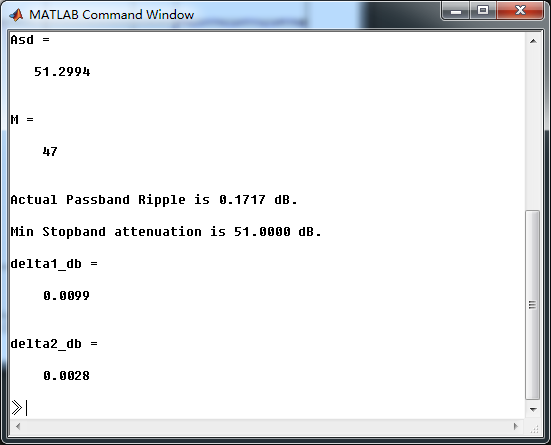
幅度谱和相位谱
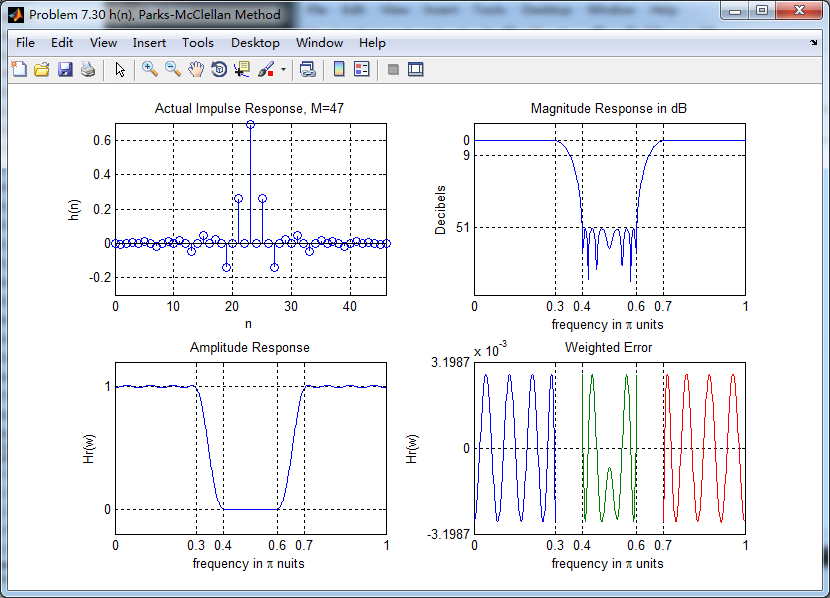
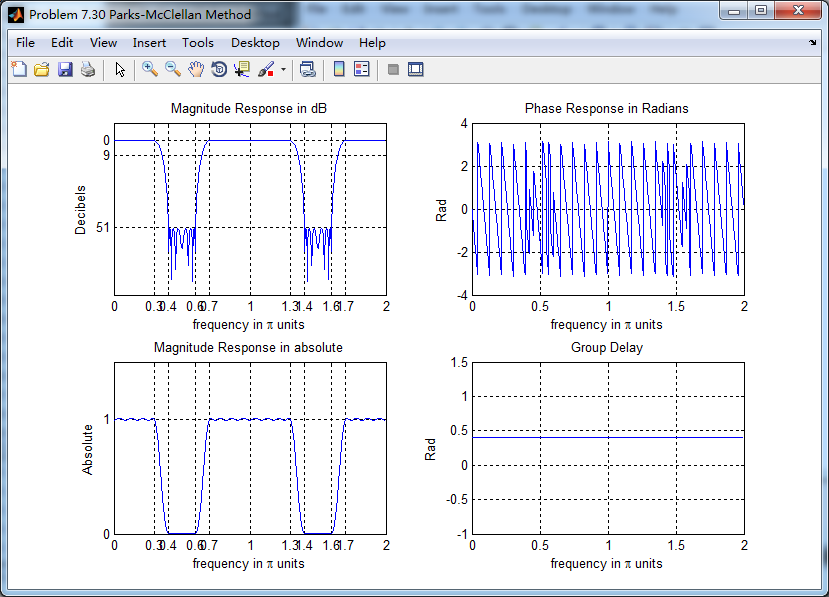
振幅谱,把阻带、通带放大,数数极值点的个数。
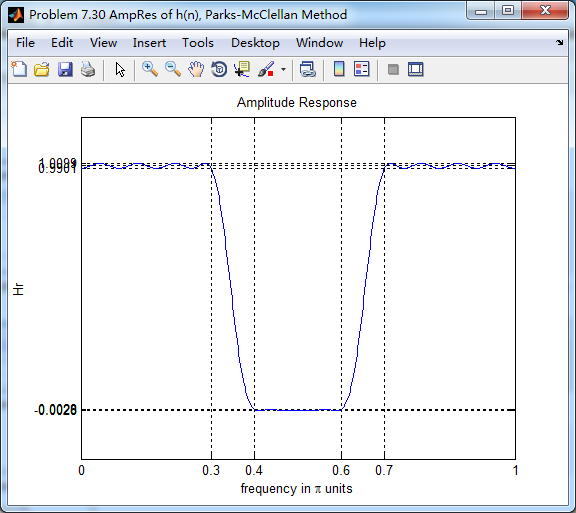
下图,9个极值点

下图,8个极值点

下图,9个极值点

总共有9+8+9=26个极值点,M=47,L=(M-1)/2=23,0到π上,最多L+3=26个极值点。
输入输出序列

输入序列的谱,注意0.5π的频率分量,通过带阻滤波后消除了。
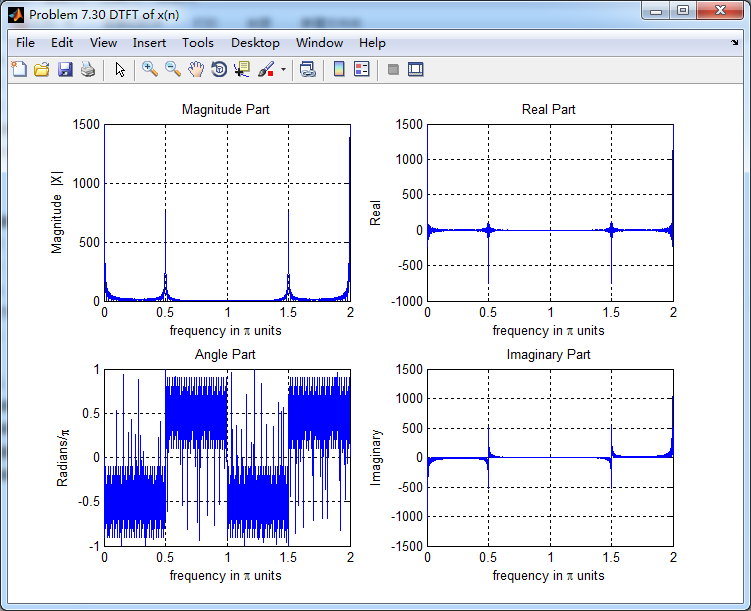
输出序列的谱,0.5π分量滤除了。
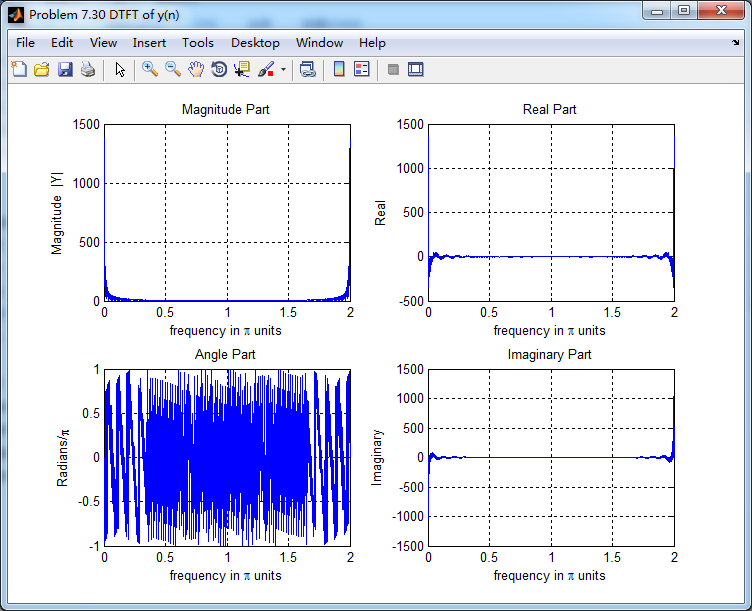
滤波前后幅度谱对比
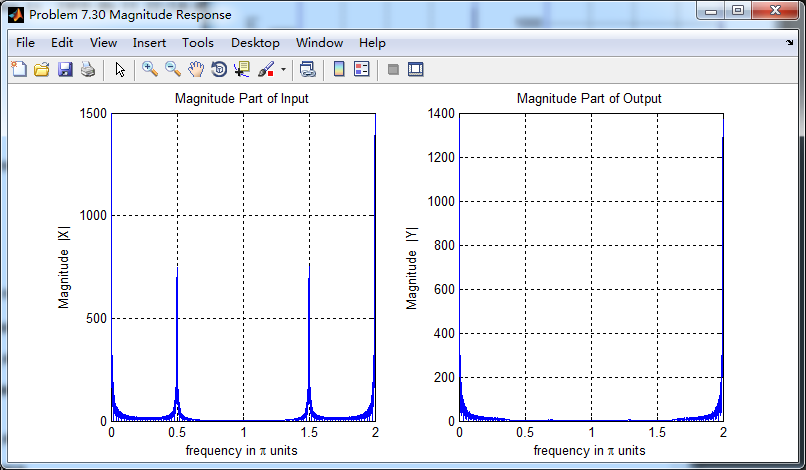
《DSP using MATLAB》Problem 7.30的更多相关文章
- 《DSP using MATLAB》Problem 8.30
10月1日,新中国70周岁生日,上午观看了盛大的庆祝仪式,整齐的方阵,先进的武器,尊敬的先辈英雄,欢乐的人们,愿我们的 国家越来越好,人民生活越来越好. 接着做题. 代码: %% ---------- ...
- 《DSP using MATLAB》Problem 5.30
代码: %% ++++++++++++++++++++++++++++++++++++++++++++++++++++++++++++++++++++++++++++++++ %% Output In ...
- 《DSP using MATLAB》Problem 7.23
%% ++++++++++++++++++++++++++++++++++++++++++++++++++++++++++++++++++++++++++++++++ %% Output Info a ...
- 《DSP using MATLAB》Problem 5.22
代码: %% ++++++++++++++++++++++++++++++++++++++++++++++++++++++++++++++++++++++++++++++++++++++++ %% O ...
- 《DSP using MATLAB》Problem 5.20
窗外的知了叽叽喳喳叫个不停,屋里温度应该有30°,伏天的日子难过啊! 频率域的方法来计算圆周移位 代码: 子函数的 function y = cirshftf(x, m, N) %% -------- ...
- 《DSP using MATLAB》Problem 3.8
2018年元旦,他乡加班中,外面尽是些放炮的,别人的繁华与我无关. 代码: %% ----------------------------------------------------------- ...
- 《DSP using MATLAB》Problem 3.3
按照题目的意思需要利用DTFT的性质,得到序列的DTFT结果(公式表示),本人数学功底太差,就不写了,直接用 书中的方法计算并画图. 代码: %% -------------------------- ...
- 《DSP using MATLAB》Problem 2.20
代码: %% ------------------------------------------------------------------------ %% Output Info about ...
- 《DSP using MATLAB》Problem 2.14
代码: %% ------------------------------------------------------------------------ %% Output Info about ...
随机推荐
- redis服务后台运行
文章目录 进入redis的安装目录 查看目录结构 进入src目录,普通启动效果 编辑redis服务目录下的redis.conf 进入src目录,执行后台运行的命令 检查服务是否开启 进入redis的安 ...
- C语言进阶学习第二章
本章重点记录指针的各种概念: 1.地址与内容 2.非法的赋值 3.NULL指针:NULL指针作为一个特殊的指针变量,表示不指向任何东西,在对指针进行解引用操作之前,首先必须 确保它并非NULL指针. ...
- day 62 Django基础之jQuery操作cookie
Django基础之jQuery操作cookie jquery之cookie操作 定义:让网站服务器把少量数据储存到客户端的硬盘或内存,从客户端的硬盘读取数据的一种技术: 下载与引入:jquery. ...
- Tomcat点击项目名称,加载一个action请求
<meta http-equiv="refresh" content="0;url=index.action">
- 豌豆荚Redis集群方案:Codis
Codis简介 Codis是一个分布式Redis解决方案,对于上层的应用来说,连接到CodisProxy和连接原生的RedisServer没有明显的区别(不支持的命令列表),上层应用可以像使用单机的R ...
- shell脚本练习05
######################################################################### # File Name: -.sh # Author ...
- shell脚本练习04
######################################################################### # File Name: -.sh # Author ...
- java_缓冲流(字节输入流)
/** * java.iko.BufferedInputStream extends InputStream * BufferedInputStream:字节缓冲输入流 * 构造方法: * Buffe ...
- 对倾斜的图像进行修正——基于opencv 透视变换
这篇文章主要解决这样一个问题: 有一张倾斜了的图片(当然是在Z轴上也有倾斜,不然直接旋转得了o(╯□╰)o),如何尽量将它纠正到端正的状态. 而要解决这样一个问题,可以用到透视变换. 关于透视变换的原 ...
- 函数的作用域、作用域链以及return关键字
1.作用域 全局作用域:在函数外部使用var关键字定义的变量 局部作用域:在函数内部使用var关键字定义的变量 特点 (1)局部变量无法直接影响全局变量 (2)在局部作用域中可以使用全局作用 ...
